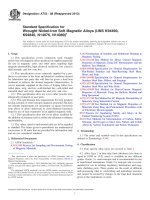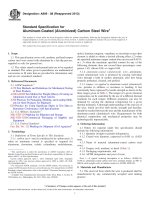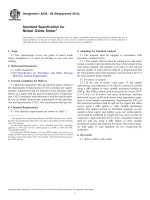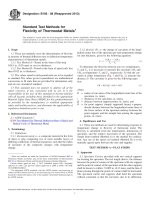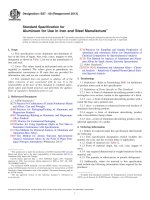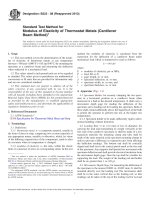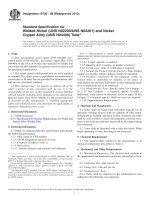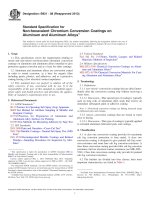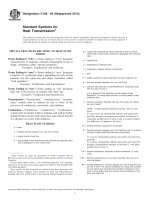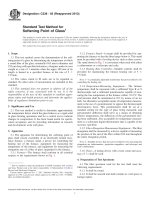Astm c 419 08 (2013)
Bạn đang xem bản rút gọn của tài liệu. Xem và tải ngay bản đầy đủ của tài liệu tại đây (66.62 KB, 3 trang )
Designation: C419 − 08 (Reapproved 2013)
Standard Practice for
Making and Curing Test Specimens of Mastic Thermal
Insulation Coatings1
This standard is issued under the fixed designation C419; the number immediately following the designation indicates the year of
original adoption or, in the case of revision, the year of last revision. A number in parentheses indicates the year of last reapproval. A
superscript epsilon (´) indicates an editorial change since the last revision or reapproval.
2. Referenced Documents
1. Scope
2.1 ASTM Standards:2
C168 Terminology Relating to Thermal Insulation
C461 Test Methods for Mastics and Coatings Used With
Thermal Insulation
C533 Specification for Calcium Silicate Block and Pipe
Thermal Insulation
C647 Guide to Properties and Tests of Mastics and Coating
Finishes for Thermal Insulation
D6/D6M Test Method for Loss on Heating of Oil and
Asphaltic Compounds
1.1 This practice covers the preparation of specimens of
mastics and coatings in the form of cured sheets or films that
may be used in other procedures for evaluation of physical
properties.
1.2 Three procedures are described for casting and curing
(Note 1) mastics and coatings of all types for thermal insulation.
NOTE 1—The term “cure” is used primarily to denote the condition that
develops as the result of loss of volatile matter but also to denote possible
subsequent changes in chemical or physical properties due to crosslinking.
1.2.1 Procedure A is intended to provide a specimen of
controlled thickness applied to insulation, and equivalent in
other respects to that obtainable under field application conditions. The thermal insulation intended for field use may be
specified as the backing.
1.2.2 Procedure B is intended to provide a free-film specimen of controlled thickness having smooth surfaces on both
sides. This type is required for some types of physical testing.
1.2.3 Procedure C is intended to provide a free-film specimen of controlled thickness having one smooth surface (as
field applied).
3. Terminology
3.1 Definitions—For definitions used in this practice see
Terminology C168.
4. Summary of Practice
4.1 Mastics and coatings are applied by a metal blade to
thermal insulation backing material in a thickness regulated by
guide bars. Moderate heat is applied to the specimens to dry or
otherwise cure them.
5. Significance and Use
1.3 The procedures of this practice are not intended for the
evaluation of application properties. These are covered in Test
Methods C461 and Guide C647.
5.1 The method of preparation of test specimens of mastic
thermal insulation coatings can have an impact upon values
obtained during testing. Testing laboratories should follow this
practice to help ensure the reproducibility of test methods for
which a cured sheet or film of a mastic thermal insulation
coating is required.
1.4 The values stated in inch-pound units are to be regarded
as standard. The values given in parentheses are mathematical
conversions to SI units that are provided for information only
and are not considered standard.
1.5 This standard does not purport to address all of the
safety concerns, if any, associated with its use. It is the
responsibility of the user of this standard to establish appropriate safety and health practices and determine the applicability of regulatory limitations prior to use.
6. Apparatus
6.1 Guide Bars—Two rectangular steel bars of thickness
equal to the desired wet thickness of the applied mastic or
coating. The guide bars shall be equal in length to the total
length of the specimens. For use on relatively soft backing
material, the guide bars may be equipped with pins projecting
1
This practice is under the jurisdiction of ASTM Committee C16 on Thermal
Insulation and is the direct responsibility of Subcommittee C16.33 on Insulation
Finishes and Moisture.
Current edition approved Nov. 1, 2013. Published March 2014. Originally
approved in 1958. Last previous edition approved in 2008 as C419 – 08. DOI:
10.1520/C0419-08R13.
2
For referenced ASTM standards, visit the ASTM website, www.astm.org, or
contact ASTM Customer Service at For Annual Book of ASTM
Standards volume information, refer to the standard’s Document Summary page on
the ASTM website.
Copyright © ASTM International, 100 Barr Harbor Drive, PO Box C700, West Conshohocken, PA 19428-2959. United States
1
C419 − 08 (2013)
from the lower surface at each end, which can be forced into
the backing to hold the bars in position during preparation of
the test specimen.
end to end of the specimen covers the entire space between the
guide bars. Remove the guide bars without disturbing the wet
specimen.
6.2 Strike-Off Bar—A flat strip of rigid metal, not less than
2 in. (51 mm) greater in length than the width of the specimen.
One edge shall be smooth and straight.
7.5 Procedure B (Free Film)—For the determination of
degree of cure as described in 8.1.2, prepare one extra
specimen in addition to the number required by the other
procedures in which they are to be used. Place a sheet of the
release paper on the backing block so that the coated surface of
the paper faces upward, away from the backing block. Place
and secure guide bars of thickness equal to the desired wet
mastic thickness on the release paper along each of the long
edges. Fill the area between the guide bars with mastic and
smooth out with a trowel to a level about 0.063 in. (1.6 mm)
above the guide bars. Place on the freshly applied mastic
another sheet of release paper with the coated surface facing
the mastic, in the following manner: Place a short edge of the
coated paper at one end of the mastic-filled area and gradually
roll the paper into the wet mastic, using the leveling roller.
Take care to prevent formation of air pockets, or bubbles, under
the paper. When firmly in contact with the mastic, roll out the
paper-covered mastic until its thickness matches that of the
guide bars. Then remove the guide bars without disturbing the
thickness of the specimen or the position of the paper. A
convenient method for accomplishing this is to slit the paper
with a sharp blade along the inside length of the guide bars.
6.3 Leveling Roller—One section of straight 11⁄2-in. (38mm) stainless steel pipe or any other convenient cylindrical
leveling tool. The tool shall have a smooth surface. Minimum
length shall be 2 in. (51 mm) longer than the width of the
specimen.
6.4 Backing Material—Unless otherwise specified by the
procedure for the test to be made, the backing for the specimen
shall consist of commercial block-type calcium silicate insulation meeting the requirements of Specification C533 and
measuring 2 by 18 by 24 in. (51 by 457 by 610 mm). The
backing block may be prepared by assembling not more than
three blocks of smaller dimensions by the use of suitable
adhesive or pins, in such a manner as to form a solid, rigid
block.
6.5 Release Paper—A smooth, dense white paper coated on
one side with dextrin, or other water-soluble gum. Size should
be approximately the same as the backing block.
NOTE 2—Films coated with PTFE or other suitable nonsoluble release
agent may be used as an acceptable alternative.
7.6 Procedure C (Free Film)—For the determination of
degree of cure as described in 8.1.2, prepare one extra
specimen in addition to the number required by the other
procedures in which they are to be used. Place a sheet of the
release paper on the backing block so that the coated surface of
the paper faces upward, away from the backing block. Place
guide bars of thickness equal to the desired wet mastic
thickness on the release paper along each of the long edges. Fill
the area between the guide bars with mastic and smooth out
with a trowel to a level about 0.063 in. (1.6 mm) above the
guide bars. Place the strike-off bar upon the guide bars at one
end of the filled area and move it slowly to the other end of the
specimen, pushing the mastic along the surface of the backing.
A see-sawing motion of the strike-off bar will be found to aid
in uniform distribution of the mastic. As the mastic is
distributed, take care to prevent inclusion of air pockets. Move
the strike-off bar from end to end of the specimen in both
directions, removing the excess material and filling the
depressions, until a coat of uniform thickness extending from
end to end of the specimen covers the entire space between the
guide bars. Remove the guide bars without disturbing the wet
specimen.
7. Preparation of Test Specimens
7.1 Stir the mastic or coating until uniform throughout the
container before removing the sample for specimen preparation.
7.2 Determine the percent volatile matter by weight in
accordance with Test Methods C461, for use in calculating the
degree of cure in 8.1.2.
7.3 Unless otherwise specified, lay down films to a nominal
wet thickness of 0.125 in. (3.2 mm).
7.4 Procedure A (Adhered Film)—For the determination of
degree of cure as described in 8.1.2, prepare one extra
specimen in addition to the number required by the other
procedures in which they are to be used. If a primer or
pretreatment of the block is specified, apply to the test
specimen in accordance with the recommendations of the
manufacturer of the mastic or coating. Place and secure guide
bars of a thickness equal to the desired wet mastic thickness on
the backing material along each of the long edges. Fill the area
between the guide bars with mastic and smooth out with a
trowel to a level about 0.063 in. (1.6 mm) above the guide bars.
Place the strike-off bar upon the guide bars at one end of the
filled area and move it slowly to the other end of the specimen,
pushing the mastic along the surface of the backing. A
see-sawing motion of the strike-off bar will be found to aid in
uniform distribution of the mastic. As the mastic is distributed,
take care to prevent inclusion of air pockets. Move the
strike-off bar from end to end of the specimen in both
directions, removing the excess material and filling the
depressions, until a coat of uniform thickness extending from
7.7 When a reinforcing membrane is specified, apply the
mastic in two separate coats of equal thickness unless otherwise specified. Immediately following the first coat press the
membrane into the wet mastic. Then apply the second coat to
the required thickness.
8. Curing Prepared Specimens
8.1 Procedure A (Adhered Film):
8.1.1 During the first 24-h hold the test specimens at 60 to
80°F (15 to 27°C). At the end of the 24-h period remove the
2
C419 − 08 (2013)
as may be necessary to reach the desired degree of cure.
Determine the degree of cure in accordance with 8.1.2.
8.2.2 Conditioning of Free Film—Allow the specimens to
cool, remove them from the backing block, and immerse in tap
water at approximately 50°F (10°C). When the paper coating
has softened (usually 20 to 30 min), strip all the paper from the
specimens and rinse them in cool (50°F, 10°C) water until no
water-soluble gum remains on the surfaces. Blot carefully to
remove excess water and allow to dry at room temperature with
good ventilation. Before using the specimens in further tests,
remove and discard the outer 0.050 in. (13 mm) of mastic
around the perimeter.
8.2.3 Measure dry thickness at several locations to the
nearest 0.001 in. (0.025 mm) with a suitable ratchet
micrometer, and record. The dry thickness at any point shall
deviate not more than 10 % from the average thickness.
specimens to a thermostatically controlled oven having a
temperature of 150 6 5°F (63 to 68°C) and hold in this oven
until the desired degree of cure has been reached.
8.1.2 To determine the degree of cure, take from the extra
specimen a sample of the coating from an area typical of that
to be subjected to test conditions during later procedures.
Determine the percentage of volatile liquids evaporated from
the mastic during the curing as follows: Weigh a 1 to 2-g
sample to the nearest 0.001 g and place it for a period of 5 h at
220 6 5°F (104 6 3°C) in an oven conforming to the
requirements specified in Test Method D6/D6M. At the conclusion of the 5-h heating period, remove the sample from the
oven, cool to room temperature, and weigh to the nearest 0.001
g. Calculate the loss in weight as a percent of the weight before
heating. Calculate the degree of cure as follows:
Degree of cure, % 5 ~ A/B ! 3 100
(1)
9. Report
where:
A = percent loss in weight, and
B = percent volatile matter (7.2).
9.1 Since this practice covers only the preparation and
curing of specimens to be tested by other methods, no report is
necessary. Data here obtained should be included in the report
of the succeeding test. These data include procedure used, dry
thickness of specimen, number of coats, presence of primer or
membrane, or both, degree of cure, and any deviation from the
stated procedure.
8.2 Procedures B and C (Free Film):
8.2.1 Do not remove the specimens from the backing block.
Allow the specimens to cure for 7 days at 60 to 80°F (15 to
27°C). At the end of the 7-day period transfer the specimens
(still on the backing blocks) to a thermostatically controlled
oven having a temperature of 150 6 5°F (63 to 68°C). Hold in
this oven for a minimum of 14 days, and for as long thereafter
10. Keywords
10.1 mastic; thermal insulation; thermal insulation coating
ASTM International takes no position respecting the validity of any patent rights asserted in connection with any item mentioned
in this standard. Users of this standard are expressly advised that determination of the validity of any such patent rights, and the risk
of infringement of such rights, are entirely their own responsibility.
This standard is subject to revision at any time by the responsible technical committee and must be reviewed every five years and
if not revised, either reapproved or withdrawn. Your comments are invited either for revision of this standard or for additional standards
and should be addressed to ASTM International Headquarters. Your comments will receive careful consideration at a meeting of the
responsible technical committee, which you may attend. If you feel that your comments have not received a fair hearing you should
make your views known to the ASTM Committee on Standards, at the address shown below.
This standard is copyrighted by ASTM International, 100 Barr Harbor Drive, PO Box C700, West Conshohocken, PA 19428-2959,
United States. Individual reprints (single or multiple copies) of this standard may be obtained by contacting ASTM at the above
address or at 610-832-9585 (phone), 610-832-9555 (fax), or (e-mail); or through the ASTM website
(www.astm.org). Permission rights to photocopy the standard may also be secured from the ASTM website (www.astm.org/
COPYRIGHT/).
3
